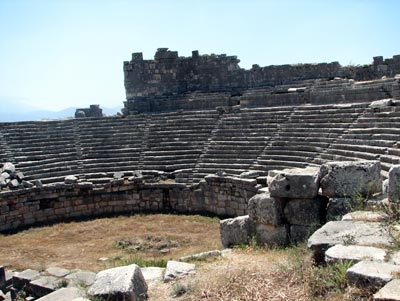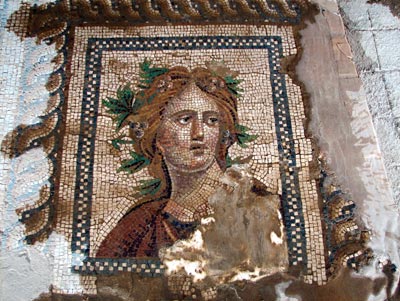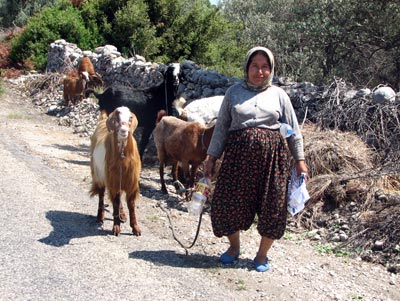Touring turkey — Using Kusadasi as a base
by Joe Phelan, Lincoln, CA
Kusadasi is one of the best-known cities in Turkey, and not without reason. With some 600 cruise ships docking there each year, thousands of people pass through this little port city on their way to visit the ancient but spectacular ruins at Ephesus. Sadly, most visitors spend not much more than an overnight in Kus¸adasi.
It’s too bad that most leave so soon. It’s an interesting town in its own right, although tourism has resulted in too many T-shirt shops and discos in the harbor area. Still, the city’s location offers access to many interesting and authentic places to explore.
In May ’07, that’s just what my wife, Rose, and I did.
Touching base with a friend
For a week, we used Kusadasi as a base to explore both Turkey’s Aegean region and a number of cities along Turkey’s Mediterranean coast. This latter stretch, toward Antalya, is called the Turquoise Coast. During our week there, we stayed with local resident and old friend Necla Isilay.
We first became friends with Necla when we hosted her in our home seven years ago. She’s a bright, effervescent blonde who loves to laugh and have fun. Her visit to our home was part of a Friendship Force (Atlanta, GA; 404/522-9490, www. thefriendshipforce.org) exchange program that brought a group from Turkey to Sacramento for a week of home hosting in 2001.
The following year we visited Turkey for three weeks (see April ’03, pg. 44). Unfortunately, we spent only a couple of days with Necla then.
Returning to Turkey this time, we made sure we had enough time to do Kus¸adasi right — and are we glad we did!
Necla made us feel much at home in her small, fifth-floor, walk-up condominium. She explained that there was no elevator because the government requires elevators only for buildings of six floors or more. That’s why so many apartment buildings are, like hers, just five stories high.
Her apartment had a small balcony where we ate all our meals, often sipping wine and nibbling cheese and olives before dinner. From the balcony we could see the harbor’s approach and, in the distance, the Greek island of Samos.
Because of our previous stay with Necla, we already had seen some of the better-known nearby sites such as Ephesus, Didyma, Miletos and Priene — and they really are not to be missed — but this time we were headed to places less known and less visited. Necla, a licensed travel guide, had a busy week scheduled for us by the time we arrived.
Metropolis
Of all the things we saw and did during the week, one of the most interesting was a visit to the ruins at Metropolis, located in the hills a short drive outside of Kus¸adasi.
Metropolis was first founded in the early Bronze Age around the third millennium B.C. Later, during the Roman period, a theater, bath and gymnasium were added. Much later, during the 14th century, a new fortress was built. In the 15th century the city was abandoned.
Today the ruins are semirestored, thanks to money from the Philip Morris Corporation. Within the ruins are remnants of elements from each of the different eras in the city’s long history. The theater and baths are in good condition, and there are wonderful mosaics on the floor of what would have been the “snack bar” for the Romans attending the theater. But this site is hard to find and, thus, not often visited.
Samos
Because we had never been to Greece, we set aside one day to ferry to the Greek island of Samos. We bought round-trip tickets ($35 each) at a helpful downtown travel agency called Discovery (e-mail ilker_discovery@hotmail.com).
As Americans, we needed no special visa for Greece, but Necla did, so Rose and I departed the next morning at 8 on our own. There were great views of Kus¸adasi and its Pigeon Island as we left.
On board, we chose to sit outside, taking photos and chatting with fellow travelers. Two hours later we rounded a rocky point and got our first glimpse of Samos.
Samos, the small, picturesque town that shares its name with the island, had colorful fishing boats and small yachts in its tiny harbor. The street running along the water was populated with sidewalk cafés and restaurants catering more to the locals than to tourists, for Samos is no tourist stop.
We walked the narrow streets, looking at bakeries, markets and the local folk shopping. Lunch was moussaka, fried calamari, a Greek salad, white beans and three glasses of wine for a tab of $34.
After lunch we walked near the water and, upon returning to town, discovered that the shops and most cafés in Samos were closed from 1 to
5:30 p.m. That left us with nothing to do but sit in the shade and wait for the ferry’s
5:00 departure. So that was that — we went to Greece and it was closed. Still, it was a fun day.
The Turquoise Coast
To really explore the coastline on our way to Antalya would have required more time than we wanted to spend. With just three days, we decided to hire a driver and do as much as we could.
As our driver we hired Mustafa Unlu (e-mail info@transferkusadasi. com), who owns his own cab and speaks fair English but better French. We had used him before and knew him to be a good driver with a new taxi. We paid less than $250 a day, which seemed fair, especially with the price of gas.
The four of us departed Kus¸adasi, driving winding roads through rocky hills and low mountains often lined with groves of wild olive trees. From time to time we passed farm wagons loaded with women going to work in the fields. Toward noon we came to our first stop, Dalyan.
Dalyan
A small river town, Dalyan was busy with Turkish tourists headed to the beach. While the history of Dalyan dates back to the sixth century B.C., today not much of it is evident. Rather, the riverfront was lined with almost identical wooden boats for hire and open-air fish restaurants.
Turkish tourists normally rent the boats by the day — to reach I˙ztuzu to swim and sun, to visit thermal springs and mud baths, for slowly cruising the river marshes and to visit the wonderful rock tombs of Kaunos just across the river.
Only with some insistence were we able to rent a boat for just two hours ($50). It proved more than enough time to visit and photograph the fourth-century-B.C. temple-like tombs carved into the rock walls across the river.
Fethiye
An easy hour’s drive from Dalyan, Fethiye is a city of 50,000 people. It’s built on a steep side of a cove that overlooks the harbor’s marina, jammed with expensive-looking sailboats called gulets.
Gulets are designed for cruising, and people rent them by the week for vacations, using them to sail around the nearby islands. Gulets allow vacationers to swim, fish and dive in secluded coves and to visit beaches and ancient ruins accessible only by boat.
For more details, visit www.commodoretour.com.
The first thing we did was head out of town to visit the extraordinary rock tombs for which Fethiye is famous. Located in an area called Bademli Bahçe, the tombs (seemingly like everything else we visited) date back to the fourth century B.C.
The most spectacular tomb on the hillside was the Grecian-looking Tomb of Aminta, once the king of Telmessos, the ancient city upon which Fethiye is built. The site also provided a grand overview of the city and harbor.
That night we ate wonderful kebabs and eggplant with garlic-laced yogurt at the waterfront Park Café. With drinks, the tab for four was $35.
With more time, we easily would have spent two or three more days in Fethiye. For information on boat or apartment rentals there, contact Marina Estate Agency (phone 0090 [0] 252 612 2936, www.marina-estates.net).
Xanthos and Kalkan
Early the next morning we drove about an hour to the ruins at Xanthos, a UNESCO World Heritage Site. Xanthos dates back to the eighth century B.C. (some believe it goes back even further, to the Bronze or Iron age). The ruins are vast and still only partially uncovered. Even with Necla’s help, it was hard to understand just what we were looking at. We walked a lot and took photos, then returned to the car.
Toward noon, we reached the beautiful little village of Kalkan. Hugging a small cove, Kalkan’s white Ottoman houses with vines of red bougainvillea made the view spectacular, especially against the deep-blue waters of the Mediterranean. Its tiny mosque with minaret was white as snow.
Fishermen were painting little boats, and people were sunning themselves on the small beach; expensive gulets and yachts were moored nearby.
But Kalkan has been discovered by foreign tourists. Prices were high in the restaurants, and a pricey large, modern hotel had just opened on the hillside.
Leaving Kalkan, we encountered a stunning stretch of ocean drive that reminded me of California’s Highway 1 between San Luis Obispo and Carmel. The road ran high above the ocean, with only a few narrow roadside turnouts. Just offshore, small islands were visible from time to time.
Access to the ocean itself was limited, but the few beaches we encountered, while small, were lovely. Parking was roadside and a bit hazardous.
Kekova and Myra
Our next stop was Kekova, a little village on a small bay containing submerged ruins of an ancient town and port. We went to the floating docks to hire a boat to visit the underwater ruins, clearly visible in the crystal-clear waters.
The captain told us the ruins were submerged after an earthquake, but Necla said the ruins were really underwater because of the rising level of the Mediterranean over the years. Again, with regrets, we had to hurry along.
After an hour’s drive, we entered the town of Myra with two things in mind to see. The first was the eighth-century Church of St. Nicholas, a lovely church building with high vaulted ceilings and well-preserved murals.
We were surprised to learn that this St. Nicholas was the same St. Nicholas we think of at Christmastime; nearby Patara was his birthplace. He is the patron saint of children, sailors and, strangely, pirates, even though it was pirates who stole his relics from the church in 1087.
The other thing we wanted to see was located just a few blocks away. Dating from Roman times, this stone theater once sat 8,000 people. Next to the theater was a large, dark wall with another wonderful rock tomb.
Finike
It had been a long day, so we hurried 30 minutes down the road to our accommodations for the night in Finike. Our driver, Mustafa, had made reservations for us at a friend’s hotel and restaurant, Finike 2000 (www.hotelfinike2000.com).
Our room was large and clean and had a great view of the harbor. The restaurant’s food was excellent. The prices were good, too; the room was about $40 for two, including breakfast.
Back to Kus¸adasi
The next morning we left early for Kus¸adasi. In the interest of time, and wanting to see new parts of Turkey, we had Mustafa take an inland route to the city.
At first our drive took us through narrow valleys bordered by high, desolate mountains. After an hour or so, small finger-like valleys started to appear and things turned more agricultural. The closer we got to Kus¸adasi, the more developed and populated the area became.
Driving was never a problem, as the roads were wide, well marked and in excellent condition.
Frankly, we were glad to get back to Necla’s apartment, as it had been a whirlwind three days. It felt good to kick back, have some wine and enjoy the view from her little balcony.
The rest of our time in Kus¸adasi was spent doing little things. Necla doesn’t own a car, so we often walked or rode one of the ubiquitous jitney buses (about 75¢), called “Indi Bindi,” which means “on off.”
We shopped at a local street fair, walked along the harbor, drank tea in the Fisherman’s Café above the harbor’s fish market and, yes, bought a carpet from a local merchant.
One day we drove to a little country village for lunch. We had börek cooked in an open, wood-burning oven. Börek is a pastry made of sheets of phyllo dough layered and folded, then filled with a mixture of cheese and meat before being baked.
On our last night in town, Ayse Ozdogru, another friend we met through Friendship Force on our last visit, took us high over the city’s harbor to a seafood restaurant for dinner. It was a great way to end a wonderful week.
It was tough saying good-bye to Necla at the week’s end. We had had such a wonderful — but busy — week. Mustafa drove us to I˙zmir’s airport and we said our good-byes, both ladies in tears.
If you’re planning a vacation in Turkey, do consider using Kus¸adasi as a base from which to explore the Aegean and Antalya regions. You can drive yourself with little trouble, as the roads are wonderful and the traffic, light, but finding some of the lesser-known ruins would be tricky. Certainly, contact Necla (e-mail necla_isilay@hotmail.com) should you want a guide or even just some help.
And, by all means, take more than a week if you can. There is too much to see and do for just one week. Looking back, we wonder how much we missed. Next time, we’ll stay even longer.





